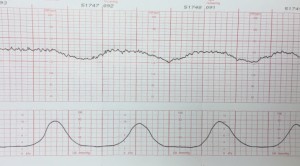Late decelerations are repetitive, periodic slowings of the fetal heartbeat toward the end of the contraction cycle.
They are gradual in onset and gradual in recovery. They are felt to represent some degree of utero-placental insufficiency.
All blood flow in and out of the intravillous space slows and then stops briefly during a contraction.
A normal fetus with normal reserve (oxygen in its bloodstream, in the blood of the placenta, and in the intravillous space) will probably not notice the tiny drop in total oxygen availability during these contractions. But a fetus who has used up its reserve, or cannot maintain its reserve, or who needs extra reserve, will, over the course of the contraction, develop some degree of hypoxia, hypercarbia and acidosis. This otherwise normal fetus will respond by slowing its heart rate to conserve energy.

The fetal heart is the largest consumer of oxygen in the fetus and if it’s rate can be slowed, the fetus will survive longer on less oxygen. After the contraction passes and fresh blood resupplies the intervillous space, the hypoxia, hypercarbia and acidosis is eased and the fetal heart rate returns to normal.
Clinically, the development of late decelerations is a worrisome sign that the fetus has very little reserve. Techniques that may be used to correct this problem include:
- Changing maternal position to improve uterine blood flow
- IV hydration to increase maternal blood volume, presumably leading to increased uterine blood flow
- Administering oxygen to the mother to try to get some additional oxygen through to the fetus. Of the three standard treatments, oxygen administration is the least useful, since the maternal hemoglobin oxygen saturation is likely already 99%. The effect of breathing additional oxygen will probably have minimal effect on the oxygen saturation.
- Decreasing or discontinuing oxytocin infusion to slow down or stop contractions that are provoking the decelerations.
- Tocolytic drugs to slow down or stop contractions that are provoking the decelerations.
If the late decelerations are persistent and non-remediable, this is considered “fetal distress,” “fetal intolerance of labor,” or a “non-reassuring fetal heart rate pattern.” Particularly when accompanied by loss of variablility, such patients should be delivered promptly to avoid fetal injury or death. Sometimes cesarean section is required to achieve prompt delivery.
If persistent and not correctable, they indicate that fetal well-being is in jeopardy.
